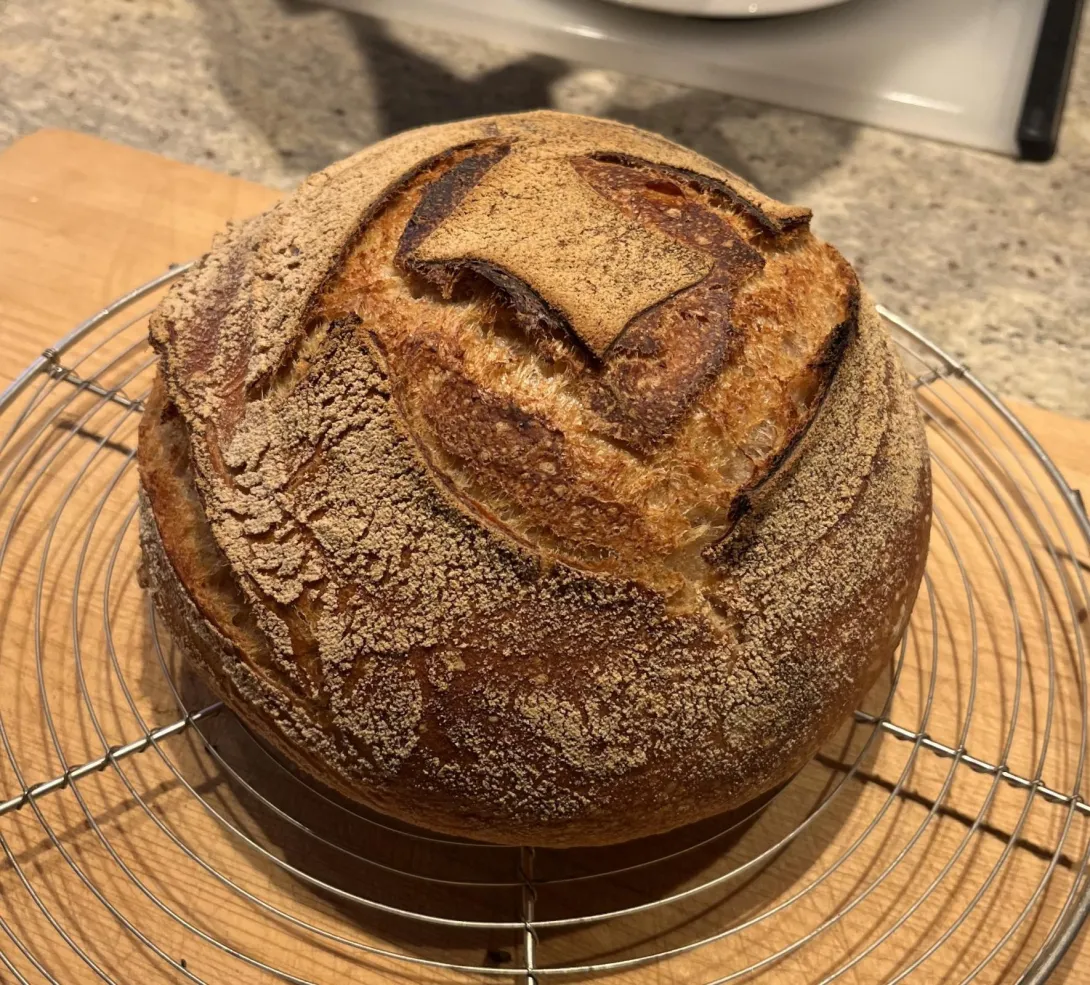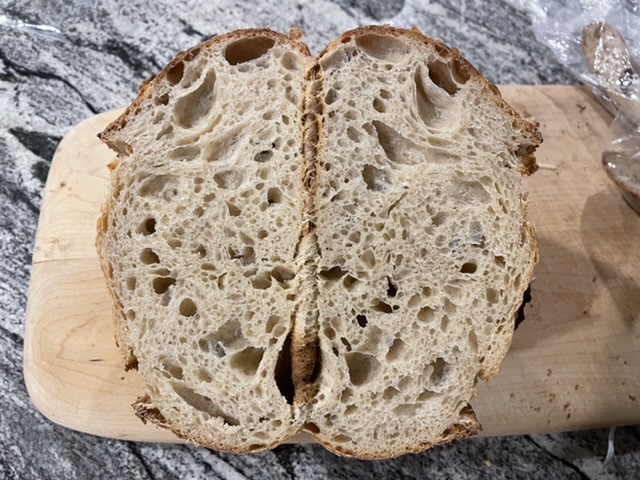
I've seen a few posts here regarding a King Arthur recipe detailed in Don't Be a Bread Hostage which was developed by Maura Brickland and then modified by Martin Philip. I've used it successfully recently but am thinking of branching out to see how it could be further modified: mixing in black olives or longer time in the fridge. I'd love to hear from others who have modified the recipe and any Do's or Don't's.
Above is one of four loaves I made last week using 750g APF, 200g Hard Red from Wildcraft and 50g WWF plus 750g water, 20g S and 100g starter.
I saw this and had to try it and it worked as advertised. I went with the mix in the morning and shape in the evening and then baked the next morning. I did 35 gr fresh starter15% WW and the rest KAAP at slightly less than 80% hydration. A great way to make bread without a lot of forethought and not have to be hands on during the day. Put a yellow ribbon on it, the hostages are free.
Don
I've railed against being subjected to the clock, pretty much since starting this journey with my first levain. My method is somewhat different than Martin/Maura's as I will mix with French Folds before a BF. And I've often used my 100% AP levain straight out of the refrigerator without a refresh.
One time I even used a 3-4 week old unrefreshed levain and the results speak for themselves...
http://www.thefreshloaf.com/node/64160/when-you-dont-refresh-starter-just-mix
Is history we haven’t read. That goes for a lot of other things like flyfishing or politics or history itself. I think Twain said history doesn’t repeat but it rhymes. Your baguettes look great per usual and the proof is in the pudding:-)

I was intrigued by this recipe not so much for the less waste part but for the small amount of starter used which just so happens to be close to the amount I keep on hand (50gr) in the fridge. I still did my weekly refresh the night before because I wanted to give it my best shot for the first attempt at this. I am still a little leery of using a fallen starter but I may have to get over that. While I still prefer a more hands on approach it was nice to walk away for 12 hours and attend to other things. The bread was good enough to make me want to try it again and experiment with other flours and add ins.
Nice to see your still perusing the pages here even though there is nothing much new under the sun.
Don
Great open crumb!
I’m glad you posted this, I’m just getting back into sourdoughs and finding it super hard to get everything organized for timing. When I was doing it before I was mostly home, working from the farm. Now I’m a single mom, work full time with two young boys and run a farm as well. This seems a lot easier and also a little more forgiving with the temperature fluctuation in my house. I run a wood stove when I get home in the afternoon and the house will get up to 26 degrees but drops back down to 16 the next day. Will give it a shot today and see how it goes!
Let me know.
Hi Grigio. I made this bread – the original version by Maura Brickman – this week and really enjoyed it for its ease and fantastic results. It looks like you made Martin Philips's version and it also looks great. I'll try that one next. It's a really solid formula. Although I didn't use any mix-ins, Martin includes hints for using them further down in his write-up under the heading "Be a Bread Boss." He suggests 20% as a good starting point for additions and recommends a minimum 3-hour soak for seeds/grains/toasted nuts and says no soaking or additional moisture is needed for olives/herbs.
Thanks for calling this formula to our attention!
–AG
That's a very nice looking loaf. I like that the recipe shows that SD baking can be more forgiving and not so dogmatic.
I haven't made this recipe yet, but I have made King Arthur's Do-Nothing Sourdough Bread. Even though I don't have a direct comparison of the methods, I think the Do-Nothing Sourdough is even more shackle-breaking than this recipe.
There are several reasons I like the Do-Nothing Sourdough:
If you want to have even less effort on a bake, you might want to try that recipe.
I recently found these KAB recipes and made both versions several times. My results weren't great, though: both under- and over-proofed. I used the B&T proofer to maintain a constant @72-degree temp during bulk but got confused when the 12-hour mark hit. Maura's version hadn't doubled, so I let it go much longer (until the surface was bubbly and domed) and that ended up being over-proofed. With Martin's, the dough doubled in just 11 hours so I rushed to the shaping and final proof. The crumb was okay but could have been more open.
My questions are:
For these successful bakes, did you allow the dough to double (even go above that, as Martin does in his video)?
Did you stop bulk if the dough doubled in under 12 hours?
How long was the final cold proof - 8 or 12 hours?
For these successful bakes, did you allow the dough to double (even go above that, as Martin does in his video)?
You have to go by what the dough is telling you, even if the times are not what you expect. I think the least you want for bulk ferment is that the dough is producing a lot of gas, that its early (maybe rubbery) elasticity has relaxed somewhat, and that the dough has not been degraded into a wet mess. It needs to be producing gas because that is what will fill up the shaped loaf and provide oven spring.
Did you stop bulk if the dough doubled in under 12 hours?
I haven't made this bread ever, but the doubling is mostly a gauge for whether the above criteria have been satisfied. I have made many successful loaves where the bulk has tripled or more. Of course, the dough has to be able to support that much increase. Many people only want the bulk to rise by 20 - 30% - that should be enough to show good gas production.
I think the main difference between that 20 - 30% and doubling or tripling is 1) in the way the gluten has developed, and 2) the texture of the crumb as baked. The long BF times tend to lead to more uniform crumbs, even when they are quite expanded. 3) Longer BF times can also lead to more flavor.
TomP
Thank you, Tom. I'll need to read this a few times to absorb it. Appreciate the detail.
I could have added that if the bulk ferment is *too* long, there might not be enough "food" left for the yeast to be able to produce enough lift and oven spring. This condition depends on the flours, the starter, the add-ins, and so on. I have hardly ever hit this point, but it's definitely possible. The signs would be that the shaped loaf doesn't want to rise much, and after baking the loaf seems flatter than expected and it might have a paler color.